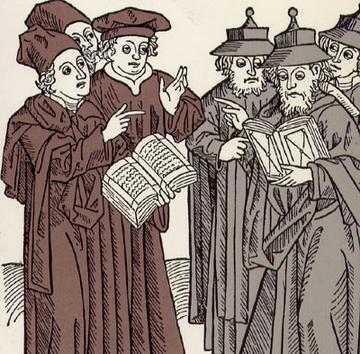
This month I’m very lucky to be taking a demo class at Hebrew Union College with the awesome AJ Berkowitz, whose research focuses on Jewish life between the Alexander the Great conquests (ca. 332 BCE) and the rise of Islam (ca. 622 CE). The course, called The World of the Rabbis, examines rabbinical engagement with the surrounding cultures and narratives. Which is how I came across a wacky, offensive medieval book called Toledot Yeshu (“the chronicles of Jesus”).
Toledot Yeshu is a mockery of the gospels, and it’s an instructive exercise to compare it to, say, Matthew. It is by no means the first example of a counternarrative designed to offend and undermine people of a different faith; Prof. Berkowitz reminded us of Apion’s revisionist history of the Exodus, as an example. What stands out immediately is how Toledot Yeshu revisits Jesus’ parentage and birth story. This undermines a crucial aspect of the Gospels – the whole story revolves around Jesus’ divinity, the virgin birth, etc. Instead, Joseph–an affectionate stepfather who refrains from approaching Mary intimately once she becomes pregnant–is recast as a vile rapist by deceit, Mary is morally blemished, and Jesus is a bastard who is (properly, apparently) ostracized. The whole thing seems carefully calculated to be as offensive as possible to Christians.
Knowing that Toledot Yeshu is likely a medieval text is helpful in understanding how and why someone would go to such lengths to produce such an aggressive refutation of the heart of Christian doctrine. I think this business is best understood against the backdrop of medieval Christian antisemitism and the Christian/Jewish polemic. The oppression and persecution of Jews in medieval Europe focused on Christian readings of the Hebrew Bible (the Old Testament) as a prelude to the arrival of the new messiah, viewing Judaism as made obsolete by Christianity. Worse, Jews are cast in Matthew as Christ’s killers (my choir, and many others worldwide, include a historical note/disclaimer in the program when performing Bach’s St. Matthew’s Passion for this very reason), the basis for various blood libel permutations. Confronted with daily hatred, discrimination, and violence, pre-modern Jews might have found the aggressive refutation of Christianity in Toledot Yeshu comforting, as it seeks to undermine the basis for their plight.
It’s worth noting, though, that there are more constructive examples of interreligious polemics in Jewish texts, my favorite of which is Yehuda Ha-Levi’s Sefer Ha-Kuzari. The book is structured as the imaginary journey of the king of the Kuzari people who, troubled by prophetic dreams, is looking for a new philosophy to live by. He talks to a Greek philosopher, an Edomite (= Christian), an Ishmaelite (=Muslim), and finally to “the friend,” who represents Judaism and is a proxy for Ha-Levi himself. Despite the fact that the work clearly posits Judaism as superior to all other philosophies, it is quite respectful to the other worldviews. Ha-Kuzari, as my hippy-dippy friends would probably phrase it, “vibrates from a much higher place” than Toledot Yeshu, and is an approach I want to believe that I would find considerably more appealing, but that’s easy to speculate, of course, from the standpoint of a 21st-century person with appreciation for free speech and the marketplace of ideas that would hardly be a factor in medieval Europe.
Thing is, the strategy of, not to put too fine a point on it, pissing on what is holiest to your adversary is still alive and well around us. One of the things I learned from my teacher and mentor Malcolm Feeley is that there is nothing new under the sun. Malcolm is a master of identifying thinking patterns and ideas across time and place, such as his masterful comparison between convict transports in the 17th century and electronic monitoring in the 21st. It is a mark of the many years I spent working with Malcolm and learning from him that I enjoy spotting these repetitive thinking patterns, and whenever I do, it makes me happy because it reminds me that I’m “Dumbledore’s man through and through.”
Anyway, it looks like some folks in current archaeological circles seem to vibrate from the same low place as Apion and the author of Toledot Yeshu. Archaeologist Brett Kaufman, whose work I’ve mentioned here before, has written a pretty depressing compendium of all the ways in which folks in his field who really should know better have been pretzeling themselves to deny Jewish indigeneity since October 7. It’s not just that the academic dishonesty and fabrication are shameful (though they are: archaeologists denying irrefutable material culture are making a mockery of their profession)–what I marvel at is the fact that people seem to feel that the current conflict and the massive suffering it is wreaking on all sides of the border should be resolved based on the kindergarten notion of “who was here first.” Nina Paley has expressed this grim ideology in this incredible animation:
[This wacky reasoning, in turn, reminds me of something I wrote about a long time ago: the way pro- and anti-same-sex marriage folks look for ideological support in biology. Every time a fruit fly is found to exhibit some sexual variation it’s weaponized as an argument for same-sex marriage; other evidence from the animal world is marshaled against it. Same story looking for sexual presentation in the animal kingdom. Why can’t the argument on behalf of same-sex marriage (which, by the way, CA voters will be invited to constitutionally affirm this week, and I hope you will, by voting “yes” on Prop 3) be made, simply, that we respect other people’s choices and lives, without getting into the question whether they are innate or predetermined? Why the preference for etiology over practicality? What difference does it make whether something is an “orientation” or a “lifestyle” if the people involved, in practice, on the ground, are happy and not hurting anybody else? But I digress.]
My frustration with the who-came-here-first answer to the current war is not just with the bad archaeologists who lie and twist. It’s also with the folks who have their history right but believe that ancient history should determine the conflict one way or the other. The idea that what seems right to you, or your birthright, or your God-given right, prevails over the realities on the ground, is terribly misguided. The situation right now is that there are multiple people with investment in, and claims to, the land, who must somehow learn to peacefully coexist if we don’t want the whole region to go up in smoke (it is already halfway there, to my great horror and sorrow).
This is what I would probably say to the Toledot Yeshu author: you can mock the virgin birth story all you like, defile your neighbors’ holiest figure, and draw some comfort from that as they defile your own history and heritage, but the endgame here is that everyone ends up filthy and disgraced. Or you can try to figure out a way to coexist with other people without hurting them or stepping all over them. The only question is who makes the choice to “vibrate from a higher place”, and how to make the benefits of putting an end to the besmirching outweigh the costs.




No comment yet, add your voice below!